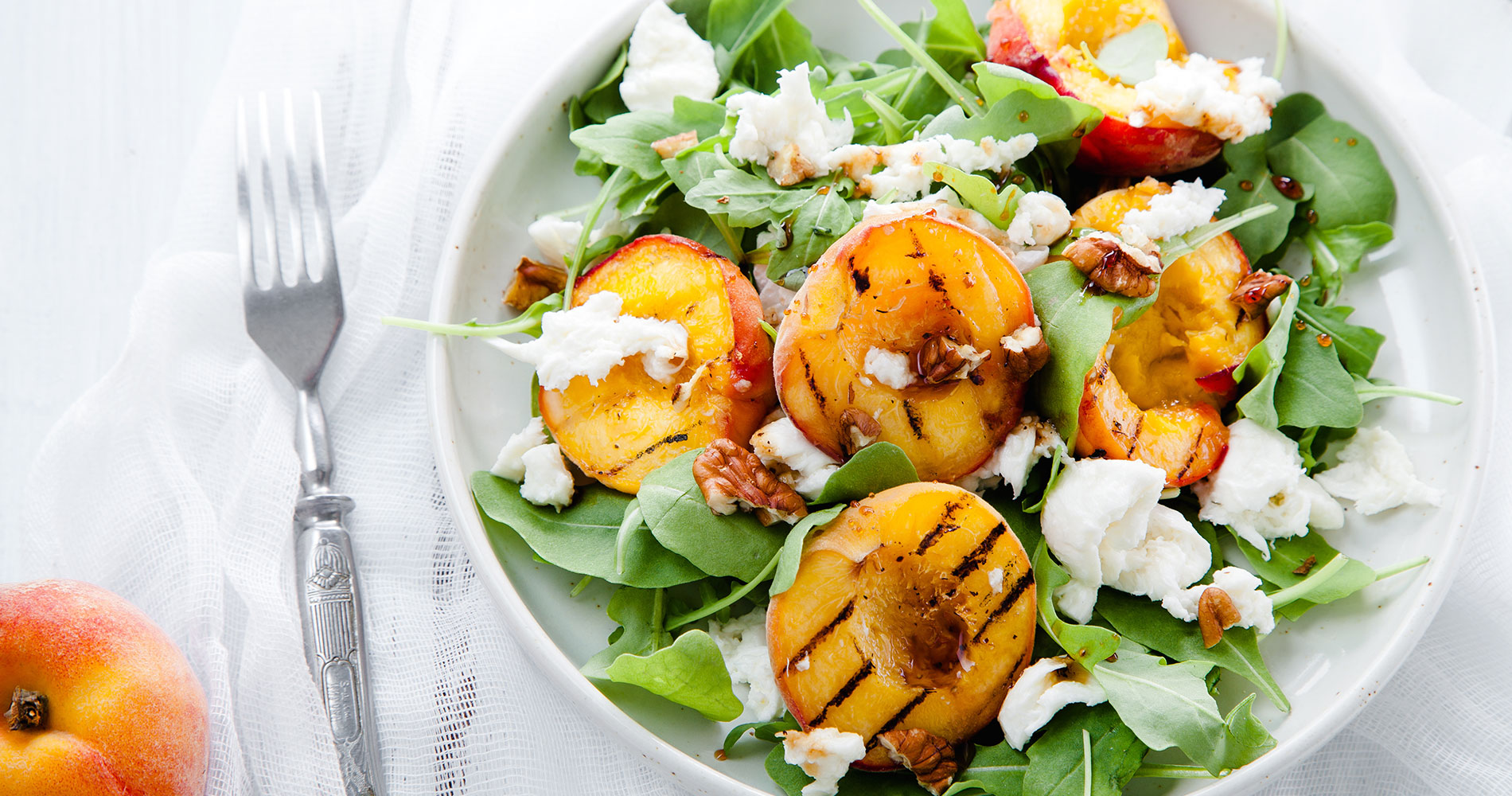Nutritious Green Foods You Didn’t Know About
Good nutrition is all about variety! Browse through our list of unusual fruits and veggies and give yourself a chance to try something new.


I’m 67 years old and weigh 208 pounds. I would like to lose a lot of weight. I’m a diabetic and take insulin 4 times a day. I can’t afford the trainers at LA Fitness. Any advice would be appreciated.
– Candace B.

Ask your endocrinologist for a referral to a certified diabetes educator (CDE®) which may be covered under a health insurance plan. These specialists help you understand how medication, exercise and diet all play a role in weight and blood sugar control and can provide advice tailored to you.
In general, I will say that regular exercise helps lower blood sugar so that less insulin may be needed. It’s like training your cells and tissues to be more metabolically active and efficient. In combination with a mild to moderate reduction of intake and shift to lower glycemic load (blood sugar response) meals, an increase in exercise should induce weight loss. Raw, unprocessed fruit, legumes, popcorn, non-starchy vegetables and whole grain products tend to be lower glycemic carbohydrate foods. By switching to these in managed portions and incorporating nuts, lean meats and healthy fats, you can lower the glycemic load of a meal.
The American Diabetes Association is a host of information on meals, recipes and fitness tips. Check out their resources at www.diabetes.org. In addition, www.diabetes.ca and www.diabetesaustralia.com.au are credible sources offering nutrition and healthy living resources in English.
– Debbie J., MS, RD
This article should not replace any exercise program or restrictions, any dietary supplements or restrictions, or any other medical recommendations from your primary care physician. Before starting any exercise program or diet, make sure it is approved by your doctor.
Some questions have been edited for length and/or clarity.
 Have a nutrition question? Our registered dietitian is ready to help!
Have a nutrition question? Our registered dietitian is ready to help!
Email nutrition@lafitness.com or submit your question below and it may be featured in an upcoming article!
Good nutrition is all about variety! Browse through our list of unusual fruits and veggies and give yourself a chance to try something new.
Does liberally salting your food help you pump more iron in the gym? Registered Dietitian, Debbie James, investigates the claims!
One frequently asked question is about the recommended intake of protein. We hear you! Here is everything you need to know.


I am 54 and I am 6’3″ and weigh 365 pounds. I have been strength training for 4 months with the help of a trainer. I need some guidance as to what to eat to lose weight. My training has been building muscle and strength but not much weight loss. I don’t always have much flexibility for dinner in what my wife cooks but I do control breakfast and lunch. I wonder if I am eating too many carbs and not enough protein. I could use suggestions for healthy breakfast, lunch, and snacks.
– Tom O.

Given your anthropometrics, age and an assumed exercise routine of 2-3x per week, your anticipated energy needs for weight loss are in the range of 3,500-4,000 calories per day. That may seem like a lot, but it’s just as possible you are maintaining with more as it is you’re maintaining with fewer calories. Your calculated resting metabolic rate (RMR) is close to 2,600 calories and you should consume that amount at minimum daily. To start, I’d take the mid-point of about 3,000 calories (half way between RMR and lower range of total energy needs) to work with.
Saving 1/3 of that figure for your evening eating gives us 2,000 calories to work with. I’d suggest dividing that between 2 meals of 750 calories each and 2 snacks of 250 calories each. Your goal isn’t to count calories exactly, but to eat a volume of healthy foods that represent those amounts.
Here are some meals and snack suggestions for you:
750 Calories
Option #1
Option #2
Option #3
Option #4
250 Calories
Option #1
Option #2
Option #3
Option #4
– Debbie J., MS, RD
This article should not replace any exercise program or restrictions, any dietary supplements or restrictions, or any other medical recommendations from your primary care physician. Before starting any exercise program or diet, make sure it is approved by your doctor.
Some questions have been edited for length and/or clarity.
 Have a nutrition question? Our registered dietitian is ready to help!
Have a nutrition question? Our registered dietitian is ready to help!
Email nutrition@lafitness.com or submit your question below and it may be featured in an upcoming article!
Good nutrition is all about variety! Browse through our list of unusual fruits and veggies and give yourself a chance to try something new.
Does liberally salting your food help you pump more iron in the gym? Registered Dietitian, Debbie James, investigates the claims!
One frequently asked question is about the recommended intake of protein. We hear you! Here is everything you need to know.


Chef Daniel DiStefano. Photo provided by: Made Nice
Meet Chef Daniel DiStefano of Made Nice, a casual dining restaurant located in NYC with roots in fine dining. The meals prepared at Made Nice marry healthy and fresh seasonal ingredients together to serve guests the very best while on-the-go.
Q: With roots based in fine dining, what caused you to make the switch to Made Nice?
Chef Daniel DiStefano: I think there’s no better way to gain a foundation in the kitchen or in a restaurant than by working in fine dining. It teaches you discipline and a strong work ethic, and you gain unique experiences that don’t exist in other restaurant environments. Unfortunately, only a handful of people in the world can afford to experience fine dining. What brought me to Made Nice was the opportunity to give many, many more people a taste of fine dining, every day.
Q: Made Nice is grab-and-go made healthy, how do you keep things fresh and the customers coming back?
DD: We change the majority of the menu seasonally, about four times per year, but we are constantly trying new flavor profile and techniques. We’re constantly evolving our menu to keep things exciting and fresh — we actually rely on change to drive our creativity.
Q: What are your two favorite ingredients to combine that many may not think go together?
DD: We often use three unexpected ingredients together to season our soups and sauces: salt, lime, and cayenne. The salt brings out the flavor, the lime balances acidity and the cayenne adds just a hint of spice. On their own, each of these ingredients has a unique flavor profile, but together they create the ultimate seasoning spice.
Q: How can our readers make healthy eating a part of their everyday lifestyle?
DD: I think most people believe eating clean or cooking from scratch is just too time-consuming. As with most things, planning ahead definitely makes it quicker and easier. In the kitchen, we often refer to the French term “mis en place,” or having everything in place. If you take a bit of time on the weekend to plan ahead for the week, it makes eating well throughout the week much easier!
Q: Does your menu change seasonally? How does incorporating seasonal produce add to the flavor of your dishes?
DD: Our menu changes seasonally about four to five times per year. We always want to serve food in its best light, when it’s freshest and tastes best. Being in NYC and having the Union Square Greenmarket just a few blocks away makes it very easy to stay inspired.
Some responses have been edited for length and/or clarity.



Made Nice NYC is located at the following location:
Distance to closest LA Fitness: 5.1 miles to North Bergen LA Fitness

Photography by: Evan Sung
Featured Recipes
Good nutrition is all about variety! Browse through our list of unusual fruits and veggies and give yourself a chance to try something new.
Does liberally salting your food help you pump more iron in the gym? Registered Dietitian, Debbie James, investigates the claims!
One frequently asked question is about the recommended intake of protein. We hear you! Here is everything you need to know.


I have trouble with overeating. I find it difficult to control myself when other people are eating unhealthy foods such as chips, pastries, pizza and fast food. My brother invites me to potlucks and there are foods there that I know I cannot control myself with. Also, my mom invites me to eat at fast food restaurants. Whenever I eat those foods, at the moment I feel good, but then 20 minutes later (or when I find out that I gained weight), I feel guilty and frustrated. I’m tired of going through the same cycle over and over again. I want to be free from that cycle and gain new healthy habits that I can manage myself, such as having willpower and control. Anything that would be helpful.
– Gema N.V.

Kudos to you for acknowledging a weakness and reaching out for help. You should have the health and nutrition your body deserves. All of the advice and education I could provide here would not in itself lead you to healthier habits, however. Willpower and self-control regarding food are really about your relationship and beliefs about food. You need to examine those (the “why”) before you can move forward (the “how”).
Keep in mind that if you have been dieting or restricting yourself, it is common to over-consume when given the opportunity. You mentioned accepting invitations from a couple of family members, so I understand the difficulty in separating yourself from those environments. However, you are responsible for what goes in your mouth and how much. Bringing your own food (even to share) may be a solution to join them while maintaining a healthy intake.
A support group or self-help guide are good options for delving into how you think about food, your body, and your nutrition, and what certain foods or eating situations may represent to you. If you are feeling trapped in a cycle of binging and guilt, consider finding an eating disorder specialist who can help you reduce feelings of shame, increase self-acceptance and steer you to a better path.
“As I began to love myself I freed myself of anything that is no good for my health – food, people, things, situations, and everything that drew me down and away from myself. At first I called this attitude a healthy egoism. Today I know it is ‘Love of Oneself’.“ — Charlie Chaplin, 1959
– Debbie J., MS, RD
This article should not replace any exercise program or restrictions, any dietary supplements or restrictions, or any other medical recommendations from your primary care physician. Before starting any exercise program or diet, make sure it is approved by your doctor.
Some questions have been edited for length and/or clarity.
 Have a nutrition question? Our registered dietitian is ready to help!
Have a nutrition question? Our registered dietitian is ready to help!
Email nutrition@lafitness.com or submit your question below and it may be featured in an upcoming article!
Good nutrition is all about variety! Browse through our list of unusual fruits and veggies and give yourself a chance to try something new.
Does liberally salting your food help you pump more iron in the gym? Registered Dietitian, Debbie James, investigates the claims!
One frequently asked question is about the recommended intake of protein. We hear you! Here is everything you need to know.


I have a potassium level of 6.0 and my doctor says I need to consult a nutritionist to fix my diet. I have a pretty simple diet day in and day out, coffee and a bagel with the cream cheese and lox for breakfast, a fresh salad with tomatoes, cucumber, radish, green onions and sour cream early afternoon, and a sandwich either with tuna salad or pastrami and V8 juice in the late afternoon. I don’t see how that can affect potassium level. I would appreciate your professional opinion on the subject. Thank you very much in advance.
– Leonard G.

While I can’t provide you individualized treatment recommendations through this forum, I will address a low-potassium diet for hyperkalemia in general. Always follow the advice of your physician. For personalized medical nutrition therapy, please visit a registered dietitian nutritionist. Find one through the Academy of Nutrition and Dietetics here.
The potential potassium content of a day’s intake with only 12 fl oz black coffee, 3 oz bagel, 2 oz lox, 2 tbsp cream cheese, salad (w/ tomato, cucumber, radish, green onion & 2 tbsp sour cream), tuna salad sandwich on wheat bread, and 12 fl oz V8 juice would be in the range of 1,500-2,000 milligrams, which is compatible with a low-potassium diet. Of course, your intake would be greater if your portions are greater.
Lists of high and low potassium foods are offered by the National Kidney Foundation. Look for areas you can reduce your intake further. Vegetable juice is listed as high potassium, whereas apple, kale, and celery are listed as low potassium. You could juice those three together for a lower potassium late afternoon drink.
– Debbie J., MS, RD
This article should not replace any exercise program or restrictions, any dietary supplements or restrictions, or any other medical recommendations from your primary care physician. Before starting any exercise program or diet, make sure it is approved by your doctor.
Some questions have been edited for length and/or clarity.
 Have a nutrition question? Our registered dietitian is ready to help!
Have a nutrition question? Our registered dietitian is ready to help!
Email nutrition@lafitness.com or submit your question below and it may be featured in an upcoming article!
Good nutrition is all about variety! Browse through our list of unusual fruits and veggies and give yourself a chance to try something new.
Does liberally salting your food help you pump more iron in the gym? Registered Dietitian, Debbie James, investigates the claims!
One frequently asked question is about the recommended intake of protein. We hear you! Here is everything you need to know.
Be the first to know about exclusive
content, deals and promotions